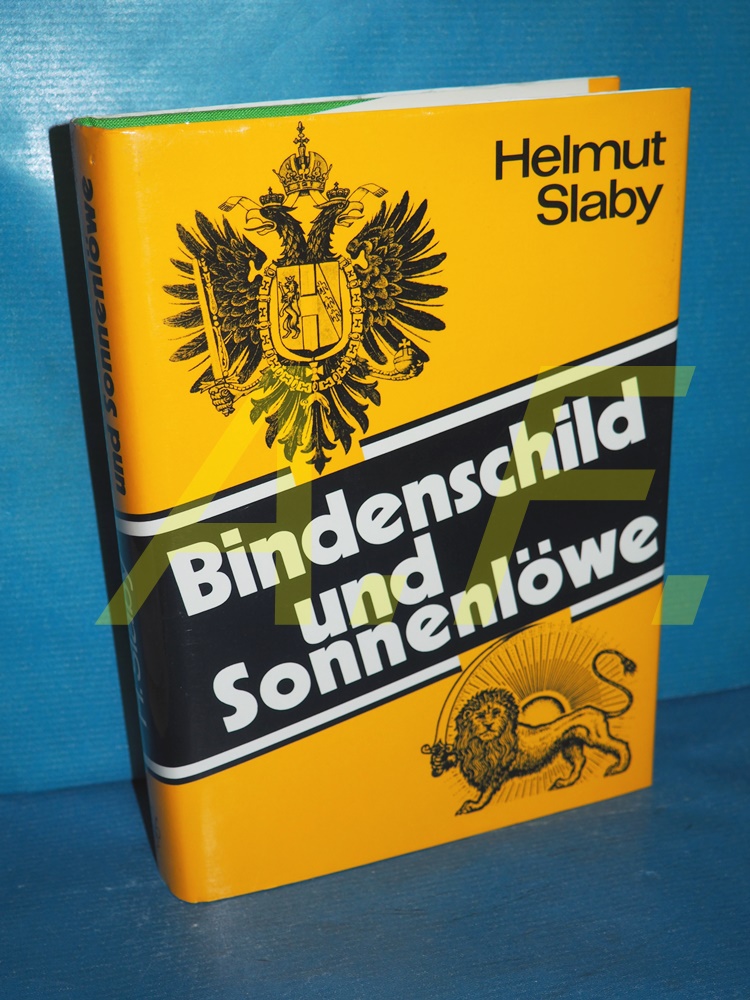
Bindenschild und Sonnenlöwe. Die Geschichte der österreichisch-iranischen Beziehungen bis zur Gegenwart - gebunden oder broschiert
1982, ISBN: 9783201011921
Graz, Akademische Druck- u. Verlagsanstalt, Gebundene Ausgabe, Publiziert: 1982T, Produktgruppe: Buch, 0.82 kg, Verkaufsrang: 3399683, Asien, Geschichte, Biografien & Erinnerungen, Katego… Mehr…
| amazon.de Antiquarische Fundgrube Gut Versandkosten:Auf Lager. Die angegebenen Versandkosten können von den tatsächlichen Kosten abweichen. (EUR 3.00) Details... |

Bindenschild und Sonnenlöwe : d. Geschichte d. österr.-iran. Beziehungen bis zur Gegenwart. - gebunden oder broschiert
1982, ISBN: 3201011924
[EAN: 9783201011921], [SC: 5.0], [PU: Graz : Akademische Druck- u. Verl.-Anst.], ÖSTERREICH IRAN GESCHICHTE ANFÄNGE-1981, UND HISTORISCHE HILFSWISSENSCHAFTEN, Jacket, 410 S. gutes Exempla… Mehr…
| ZVAB.com Antiquarische Fundgrube e.U., Wien, Austria [60361656] [Rating: 5 (von 5)] Versandkosten: EUR 5.00 Details... |

Bindenschild und Sonnenlöwe. Die Geschichte der österr.-iranischen Beziehungen bis zur Gegenwart - gebunden oder broschiert
1982, ISBN: 3201011924
[ED: Hardcover/gebunden], [PU: Akademische Druck- u. Verlagsanstalt], h4, AT, [SC: 9.90], leichte Gebrauchsspuren, gewerbliches Angebot, 210x147 mm, 410, [GW: 600g], Banküberweisung, Selb… Mehr…
| booklooker.de |

Bindenschild und Sonnenlöwe., Die Geschichte der österreichisch-iranischen Beziehungen bis zur Gegenwart. - gebrauchtes Buch
1982, ISBN: 9783201011921
[ED: Leinen], [PU: Akad. Dr.- u. Verl.-Anst.], XII, 410 S., Ln. 2., DE, [SC: 3.00], gewerbliches Angebot, [PU: Graz/Austria], Banküberweisung, PayPal, Selbstabholung und Barzahlung, Offen… Mehr…
| booklooker.de |

Bindenschild und Sonnenlöwe. Die Geschichte der österreichisch-iranischen Beziehungen bis zur Gegenwart. - gebunden oder broschiert
1982, ISBN: 3201011924
[EAN: 9783201011921], [SC: 3.0], [PU: Graz/Austria, Akad. Dr.- u. Verl.-Anst.], XV ISLAMISCHER KULTURKREIS, XII, 410 S., Ln. 2., Books
| ZVAB.com Antiquariat Kai Groß, Gleichen OT Bischhausen, Germany [62853723] [Rating: 5 (von 5)] Versandkosten: EUR 3.00 Details... |


Bindenschild und Sonnenlöwe. Die Geschichte der österreichisch-iranischen Beziehungen bis zur Gegenwart - gebunden oder broschiert
1982, ISBN: 9783201011921
Graz, Akademische Druck- u. Verlagsanstalt, Gebundene Ausgabe, Publiziert: 1982T, Produktgruppe: Buch, 0.82 kg, Verkaufsrang: 3399683, Asien, Geschichte, Biografien & Erinnerungen, Katego… Mehr…

Slaby, Helmut:
Bindenschild und Sonnenlöwe : d. Geschichte d. österr.-iran. Beziehungen bis zur Gegenwart. - gebunden oder broschiert1982, ISBN: 3201011924
[EAN: 9783201011921], [SC: 5.0], [PU: Graz : Akademische Druck- u. Verl.-Anst.], ÖSTERREICH IRAN GESCHICHTE ANFÄNGE-1981, UND HISTORISCHE HILFSWISSENSCHAFTEN, Jacket, 410 S. gutes Exempla… Mehr…

Bindenschild und Sonnenlöwe. Die Geschichte der österr.-iranischen Beziehungen bis zur Gegenwart - gebunden oder broschiert
1982
ISBN: 3201011924
[ED: Hardcover/gebunden], [PU: Akademische Druck- u. Verlagsanstalt], h4, AT, [SC: 9.90], leichte Gebrauchsspuren, gewerbliches Angebot, 210x147 mm, 410, [GW: 600g], Banküberweisung, Selb… Mehr…
Bindenschild und Sonnenlöwe., Die Geschichte der österreichisch-iranischen Beziehungen bis zur Gegenwart. - gebrauchtes Buch
1982, ISBN: 9783201011921
[ED: Leinen], [PU: Akad. Dr.- u. Verl.-Anst.], XII, 410 S., Ln. 2., DE, [SC: 3.00], gewerbliches Angebot, [PU: Graz/Austria], Banküberweisung, PayPal, Selbstabholung und Barzahlung, Offen… Mehr…
Bindenschild und Sonnenlöwe. Die Geschichte der österreichisch-iranischen Beziehungen bis zur Gegenwart. - gebunden oder broschiert
1982, ISBN: 3201011924
[EAN: 9783201011921], [SC: 3.0], [PU: Graz/Austria, Akad. Dr.- u. Verl.-Anst.], XV ISLAMISCHER KULTURKREIS, XII, 410 S., Ln. 2., Books
Bibliographische Daten des bestpassenden Buches
| Autor: | |
| Titel: | |
| ISBN-Nummer: |
Detailangaben zum Buch - Bindenschild und Sonnenlöwe. Die Geschichte der österreichisch-iranischen Beziehungen bis zur Gegenwart
EAN (ISBN-13): 9783201011921
ISBN (ISBN-10): 3201011924
Gebundene Ausgabe
Erscheinungsjahr: 1982
Herausgeber: Graz, Akademische Druck- u. Verlagsanstalt,
Buch in der Datenbank seit 2008-02-04T14:17:46+01:00 (Berlin)
Detailseite zuletzt geändert am 2024-04-20T13:04:19+02:00 (Berlin)
ISBN/EAN: 3201011924
ISBN - alternative Schreibweisen:
3-201-01192-4, 978-3-201-01192-1
Alternative Schreibweisen und verwandte Suchbegriffe:
Autor des Buches: slaby helmut, kofler, stampfer
Titel des Buches: bindenschild und sonnenlöwe, geschichte österreich, geschichte iran, der bindenschild, philosophisch, klasse geschichte, österreichische geschichte
Daten vom Verlag:
Autor/in: Helmut Slaby
Titel: Bindenschild und Sonnenlöwe - Die Geschichte der österreichisch-iranischen Beziehungen bis zur Gegenwart
Verlag: Akademische Druck- u. Verlagsanstalt
422 Seiten
Not available (reason unspecified)
17 schw.-w. Abb.
BB; LEINEN
Weitere, andere Bücher, die diesem Buch sehr ähnlich sein könnten:
Neuestes ähnliches Buch:
9783700137948 Bindenschild und Sonnelowe: Die Geschichte der osterreichisch-iranischen Beziehungen bis zur Gegenwart Helmut Slaby Author (Slaby, Helmut)
< zum Archiv...

